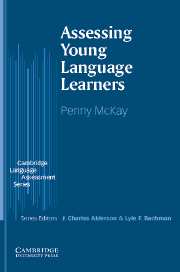Book contents
- Frontmatter
- Contents
- Series editors' preface
- Acknowledgments
- 1 A special case for young learner language assessment
- 2 Young learners and language learning
- 3 Research into the assessment of young language learners
- 4 Assessing language use through tasks
- 5 Classroom assessment of language use
- 6 Assessing oral language
- 7 Assessing reading and writing
- 8 Evaluating young learners' performance and progress
- 9 Testing young language learners through large-scale tests
- 10 The way forward
- References
- Index
- Publishers' acknowledgments
Series editors' preface
Published online by Cambridge University Press: 04 May 2010
- Frontmatter
- Contents
- Series editors' preface
- Acknowledgments
- 1 A special case for young learner language assessment
- 2 Young learners and language learning
- 3 Research into the assessment of young language learners
- 4 Assessing language use through tasks
- 5 Classroom assessment of language use
- 6 Assessing oral language
- 7 Assessing reading and writing
- 8 Evaluating young learners' performance and progress
- 9 Testing young language learners through large-scale tests
- 10 The way forward
- References
- Index
- Publishers' acknowledgments
Summary
Recent years have seen considerable growth in the number of children learning a second or foreign language, as the importance of being able to use a language other than one's first language has become recognized in an increasingly globalized world. In Asia and Europe in particular, there has been a tendency to lower the age at which school children begin to learn a foreign language, since it is believed that the earlier a child starts to learn a foreign language, the greater the ultimate achievement will be. In addition, in many regions of the world, vast numbers of children attend schools in which the language of instruction is not the same as their native or mother tongue. In many African countries, for instance, the language of education is not the same as the language of the home for the majority of children. In many settings, the children of immigrants must not only deal with the same subject matter as their classmates for whom the language of instruction is their native language, but also acquire that language as a second, sometimes as a third, language. Such children are variously referred to as ‘bilingual students’, ‘foreign language (FL) learners’, ‘second language (SL) learners’, ‘pupils having English as an additional language (EAL)’, ‘students of non-English-speaking background (NESB)’ or ‘English language learners (ELLs)’. In many countries, these ‘young language learners’ comprise a sizeable proportion of the school-age population.
- Type
- Chapter
- Information
- Assessing Young Language Learners , pp. ix - xiPublisher: Cambridge University PressPrint publication year: 2005



